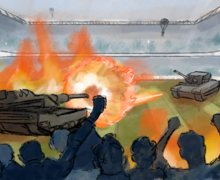Opinion: Don’t scroll past tragic news without reevaluating your role
Emma Lee | Contributing Illustrator
Our columnist says a new digital age of social media puts us in direct connection with the faces and places at the center of global tragedies. As the media and how we engage evolves, so must our collective response.
Get the latest Syracuse news delivered right to your inbox.
Subscribe to our newsletter here.
The impact of news media throughout history is a crescendoing one. Historically, when a war or tragedy written about in the paper was thousands of miles away it was very easy to detach yourself from it. News was emphasized nationally, yet it was as impersonal as words on a page. When mostly every American bought a television in the 20th century, war arrived in their living rooms — but even then, you could still change the channel.
Today, when phones and social media are such integral parts of people’s everyday lives, we’ve reached a point where shutting yourself off from the world’s ills is impossible. Our new digital age puts us in direct connection with the faces and places at the center of global tragedies.
Instagram Reels and TikTok have recently been flooded with real videos of desperate families pleading for aid in Gaza and footage of people’s livelihoods burning to the ground in California. It’s a level of intimacy with tragedy we’ve never seen before. Though it may be easiest, don’t let apathy be the knee-jerk response to these tragedies; we’ve got to stop patting ourselves on the back for so-called “spreading awareness.” In a world where visibility is more prevalent than ever, assistance from afar and reckoning with the issues at hand are the next best steps.
When social media first emerged as a legitimate concept at the turn of the century, its creators and users probably wouldn’t have been able to predict the apocalyptic scenes shown on a typical social media feed today. Scrolling in 2005 was a cutting-edge way to simply share unglamorous and ordinary photos from your life.
Now, at our fingertips are videos of 90 mile-per-hour winds spreading gargantuan fires through southern California, a Cybertruck explosion in Las Vegas, carnage in Gaza and at an Israeli music festival, and pedestrians reeling in New Orleans on New Year’s Day after a truck drove through a crowd. Content like this is par for the course during a social media session nowadays.
As the media and our engagement with it both evolve, so must our collective response. Catastrophe has gone from a spectator sport that you could choose to watch, to a mass participant spectacle we can’t opt out of.

Alex Levy | Design Editor
Gone should be the days when engaging with the news ends with reading it. For many years, activism and journalism have focused on visibility and awareness of suffering in the world. That question is answered; now, we must decide what we do about all that’s made visible.
It’s easy to half-heartedly argue, “Well, what could I even do about it?” In 2025, we have more options to be active than ever before, exemplifying our unique opportunity in this time.
There are several ways one can actively respond to the horrors of the world seen on screens. For those with added economic freedom, financial contribution has always been an option. Traditional charities like United Way or Save the Children are well known and respected, but there are now numerous crowdfunding options with personal ways to contribute.
I’m not introducing a new concept by pitching the idea of donating to charitable causes. But what I do establish is that donating to these outlets shouldn’t be extracurricular to engaging with the news, and it should certainly be the instinctual response for those in our nation who have money to burn.
It’s not enough that the LA fires have dominated the news the last few weeks. Practical acknowledgment of climate change and its cataclysmic effects on ordinary life must become the natural response to the news we see daily.
We can’t only read about the recent ceasefire in the Israel-Hamas war. Our celebrations of advancements in geopolitical policy must involve more than simply being in the loop.
It’s impossible to not be over-exposed to information like this, so the duty falls on us to use our social media presence and aptitude — as well as our voting power — to influence aid. This content is not just a blip on social media. It shows issues we shouldn’t turn uncaring eyes to.
We as young adults and students at Syracuse University are uniquely equipped to shoulder these demands. We are still forming our media habits and, on top of that, we are the largest user base of social media, which gives us the ability to unite online in ways that can influence real change to our stark reality.
The paint isn’t dry for Gen Z — our digital abilities are expanding. Interrupt the initial impulse to keep scrolling when you see stories of mass devastation. Don’t abruptly move on from them as if they’re merely surface-level stories from the week.
Attending SU means we’re part of a group possessing certain financial privileges and educational opportunities that aren’t afforded to so many people. Therefore, it’s wrong for us to be apathetic. We should use our collective presence on social media to channel genuine good, turning simplistic consumption of media into a more symbiotic relationship.
Ben Newman is a freshman at Syracuse University. His column appears bi-weekly. He can be reached at ibnewman@syr.edu.
Published on January 21, 2025 at 9:10 pm






